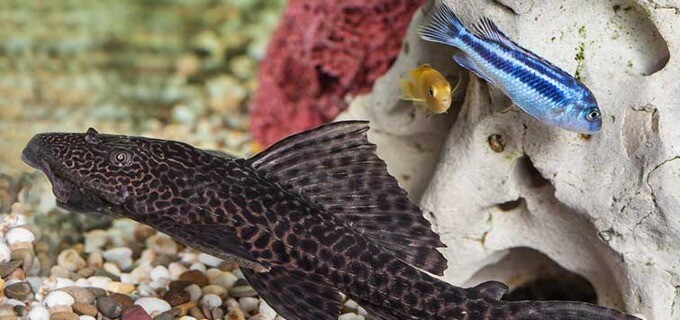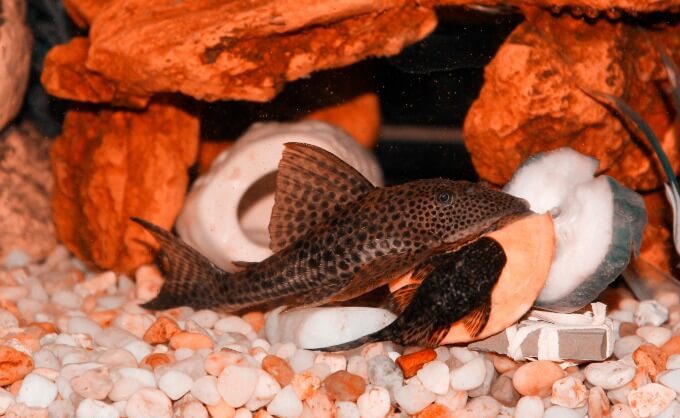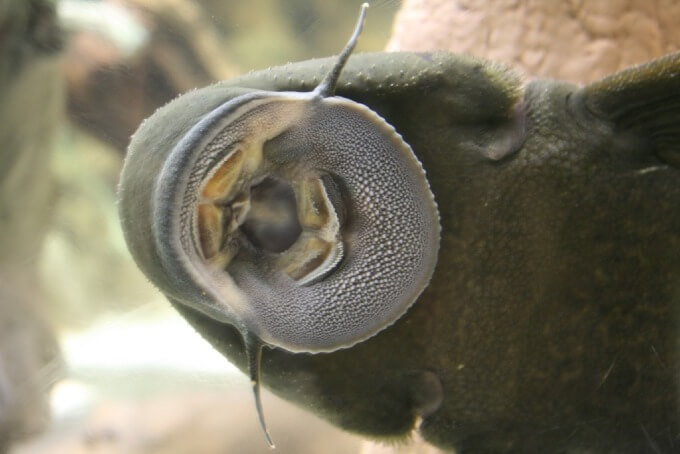Uxcell Aquarium Fish Tank Ceramic Plecos Cave Reviews
Common Plecos are a very popular freshwater fish that take been kept in the aquarium community for ages. They're hardy, straightforward to intendance for, and very fun to observe.
Only despite the popularity of this fish, at that place'south really a lot of inaccurate information passed around near them online. This results in newer aquarists making mistakes and providing poor intendance without knowing it!
This guide will cover the essentials of Common Pleco care. You'll learn about their diet, ideal tank size, tank mates, lifespan, size, and more!
Table of Contents
- Species Summary
- Mutual Pleco Lifespan
- Appearance
- Average Common Pleco Size
- Care
- Tank Size
- Water Parameters
- Setting Up The Residual Of Their Tank
- Mutual Potential Diseases
- Food & Nutrition
- Behavior & Temperament
- Tank Mates
- Breeding
- Determination
Species Summary
Lovingly referred to every bit a "Sucker Fish" in many circles, the Mutual Pleco (scientific name: Hypostomus plecostomus) is a freshwater aquarium staple! These fish have been in the trade for decades and continue to captivate fish enthusiasts.

The Common Pleco belongs to the Loricariidae family, which is a large group of armored catfish species. Originally, this species comes from Due south America. Specifically, they are abundant in countries similar Brazil, the Guianas, and Trinidad and Tobago.
Author Annotation: Common Plecos have started to appear in several countries around the world, likewise. Due to pet owners releasing these fish into the wild, they're considered an invasive species in many regions.
There are many misconceptions about this fish. If you're thinking well-nigh owning a Common Pleco, information technology's important to get a good agreement of what caring for this fish entails.
Common Pleco Lifespan
In pristine weather condition, the typical Common Pleco lifespan is between ten and 15 years! They take a longer life expectancy than most tropical fish, then be prepared for years of care.
As always, at that place's no guarantee with whatsoever fish species when it comes to lifespan. The quality of intendance you provide will impact the fish's overall health for better or worse.
Appearance
Common Plecos have a signature shape that you might have seen earlier. Like catfish, all types of plecos accept an underturned oral fissure, flat abdomen, and expansive fins.
When it comes to coloration, Common Plecos are pretty simple. They have a base of operations colour of brown. Several small blackness splotches embrace the entire torso, creating a unique net-like effect.
Author Annotation: Other color variations do exist. You might see some Plecos that are lighter or those that take sand-colored spots. The coloration of this fish varies based on the surround they come from.
On top of their body, these fish have a unique physical characteristic. They have several rows of armor plates! These plates are tough and offer loads of protection from predators.
These fish are bottom-dwellers, so that added protection from higher up is essential. On their bellies, Common Plecos don't accept armor at all.

Similar other fish in the Loricariidae family, Mutual Plecos have impressive fins. The dorsal fin is expansive and has several rigid fins. The same goes for the tail, pectoral, and pelvic fins.
On the head, Common Plecos have small beady optics. These fish are nocturnal, so the eyes are equipped with tissue that regulates the amount of low-cal getting in. On the lesser of the head, you'll find that iconic sucker mouth!
Boilerplate Mutual Pleco Size
The average Mutual Pleco size in captivity is around fifteen inches in length when fully grown. They're known to have a max size every bit big as 24 inches in the wild!
Some specimens living in massive environments can reach similar lengths in captivity, although this is pretty rare.
When y'all first buy a Mutual Pleco, information technology'll likely be a few inches in length at most. But don't let that modest size fool you! As we've said, these fish can get huge and have a pretty steady growth rate.
Care
Proper Common Pleco care isn't a huge challenge. These fish adjust well to a wide range of environments. Plus, they accept healthy appetites for pretty much any food they can find!
That said, keeping a Common Pleco healthy isn't every bit easy as some people think. They accept distinct care requirements and some behavioral quirks you need to address.
Here are some care tips you tin can follow to go on your Mutual Pleco happy and good for you.
Tank Size
Developed Mutual Plecos demand a tank size of 75 to eighty gallons at the very minimum. However, to help your fish reach its full size and potential you'll need at least 150 gallons!
Larger is e'er meliorate with the Common Pleco.
If you program on starting small, these fish do well in tanks that can hold up to thirty gallons when they're juveniles.
Author Note: Tank size is where many start fishkeepers go incorrect with the Common Pleco.
Because these fish are usually sold every bit juveniles, some people think that they'll practise fine with a smaller tank. Those smaller tanks are fine equally the fish grows, only you lot're going to accept to move them to a much larger aquarium at some point.
H2o Parameters
Common Plecos practise best in environments that replicate their natural habitat in the wild. This includes both decor (more on that in the section below) and water weather!
These freshwater fish come from wearisome-moving tropical rivers. The waters are warm and highly oxygenated. Here are some basic parameters to stick to when setting up your fish's new home.
- Water temperature: Between 72°F and 86°F (somewhere in the middle of this range is ideal)
- pH level: Neutral pH rest between vi.v and 7.v
- Water hardness: Upwards to 25 dGH
Stick to a consistent schedule when information technology comes to testing the h2o (one time a week should be fine). Information technology's very of import to make sure the parameters and general conditions are stable.
Setting Up The Remainder Of Their Tank
To replicate the Common Pleco's natural surroundings, go with traditional riverbed decorations. These fish will spend most of their time at the lesser of the tank, and then spend some fourth dimension getting the decorations just right.
Use a fine sand substrate at the bottom. Common Plecos practice fine with gravel, just sand is softer and less likely to crusade injury.
On peak of the sand, conform live plants. The plants will deed as a shelter from the light. Side by side, add together some natural caves and driftwood.

Caves are essential for this nocturnal fish. They'll hide out in the shadows to get some residuum during the twenty-four hour period. A cave will cake out low-cal while keeping the fish protected from any other nosy fish in the tank.
Driftwood is important, too. These fish like to munch on driftwood for a source of fiber. It'll also abound algae, which is another important food for the Common Pleco.
Keep lighting relatively subdued. At night, the tank should be nighttime. Utilize a red light to view the fish after hours.
As for filtration, get with the most powerful option you can find (our recommendation would exist the Fluval FX4). Common Plecos produce a lot of waste material. They're constantly eating, which can sour the h2o quality pretty quickly.
Author Annotation: Many Pleco owners prefer to over-filter the h2o. This means that they take a filtration arrangement that'southward more powerful than what their tank would normally need. With the large size of the Pleco, that extra power can do a lot to keep ammonia and nitrate levels in check.
Common Potential Diseases
Plecos can suffer from all of the same diseases as other freshwater fish. Many believe that Plecos are more sensitive to disease. While they accept big plates of armor, these fish don't accept pocket-sized scales to protect their trunk from contaminants and bacteria.
Some common diseases yous might encounter are ich and dropsy. Ich is a common ailment that's usually caused by stress. It's very contagious and causes small white bumps to form all over the fish'south torso.
Dropsy is a form of bloat. The fish'due south body starts to swell upwardly with fluids, making it difficult to swim.
Your fish may also experience bacterial or fungal infections. These maladies tend to accompany other diseases.
Fortunately, all of these issues are very preventable.
They're commonly caused by poor h2o weather condition. Use a examination kit to bank check conditions regularly. You should also perform 30-percent water changes every calendar week to back up the filtration organisation.
If your fish contracts a illness, quarantine them to outset treatment immediately. Use a Pleco-approved medication or utilize natural treatment methods to cure your fish. Common Plecos tin can exist sensitive to copper-based medicines, so exercise caution.
Food & Diet
Many pets stores market Common Plecos as some of the best algae eaters. And information technology's true that they will consume algae every once in a while.
All the same, it shouldn't be their diet staple.
Common Plecos are omnivores with a big ambition. They will constantly scavenge the tank for nutrient to eat. These fish will consume annihilation they can become their mouths on, so yous shouldn't take trouble getting them to swallow!

A varied nutrition of vegetables and protein-based foods is ideal. You tin can supply blanched lettuce, zucchini, peas, and more than for vitamins and nutrients.
For protein, consider live or frozen snacks. This can include bloodworms, small-scale crustaceans, fly larvae, and earthworms.
Author Annotation: You lot can also provide sinking dry nutrient. Common Plecos enjoy balanced pellet food and algae wafers.
Behavior & Temperament
When they are young, Common Plecos are pretty easy-going. They get forth well with most fish of a similar size.
Nonetheless, that changes one time they achieve adulthood. These fish tin showroom ambitious behavior when they are fully grown.
This is primarily because they can become territorial. This behavior applies to fifty-fifty fish of the same species!
In general, Common Plecos prefer to stay alone and volition have no problem attacking other fish. They seem to target brightly colored fish with flowing fins, such as Angels and Discus.
Don't expect to see much activity during the day. This species volition spend their days in hiding equally they rest.
After the dominicus goes down, these fish will go into scavenging way! They'll use their sucker mouths to cling onto glass, eat algae, and grub down on driftwood. Plecos are constantly eating, so it's never a wearisome moment when they're awake.
Tank Mates
Because of their territorial behavior, you can actually go on Common Plecos with other semi-aggressive fish. This might seem unsafe, only it'southward really beneficial for every fish involved.
Common Plecos are tough enough to stay safety. Their armored bodies can protect them from nips and bites. Usually, semi-aggressive fish develop common respect for each other and larn to coexist.
Your best bet would be to choose similarly sized fish that occupy other parts of the water column. Yet, smaller peaceful fish that spend their time near the acme of the aquarium can work besides. Common Plecos are bottom dwellers, so they won't bump into fish that stay in the middle and upper parts of the tank.
Here are some skillful tank mates to endeavor:
- Oscar Fish
- Dwarf Gourami
- Flowerhorn Cichlid
- Dear Gourami
- Black Brim Tetra
- Dark-green Terror Cichlid
Breeding
Breeding Mutual Plecos in captivity is extremely difficult, and there are a couple of reasons for this.
First, you would need a massive tank. Two adult Common Plecos need around 300 gallons of infinite to stay healthy!
Secondly, the territorial nature of this species makes it tough. Most fish will just fight to the death rather than spawn.
Convenance is much easier if you're able to raise Common Plecos together as a bonded pair. If you're lucky enough to go your hands on a pair, the breeding process is straightforward.
Males volition find a suitable cavern for spawning. He'll and then make clean the cavern and invite the female. She will then lay her eggs on the side of the cave. Males watch over the eggs until they hatch, which takes a few days.
Generally, breeding Common Plecos is reserved for professionals with massive breeding tanks. Don't wait to run into much success if you try to breed the fish at home.
Conclusion
If you're looking for a large but depression-maintenance freshwater fish, the Common Pleco is a great choice. There'south a reason this species has been popular for and so long!
There's something virtually their size and simplicity that's really fun to sentinel. Seeing this large aquatic brute motility around the tank is rather mesmerizing.
If you lot have any lingering questions about Mutual Pleco care we would be more than happy to chat with you. Simply shoot united states an email and we'll accomplish out every bit before long every bit we tin can!
Source: https://www.aquariumsource.com/common-pleco/
0 Response to "Uxcell Aquarium Fish Tank Ceramic Plecos Cave Reviews"
Postar um comentário